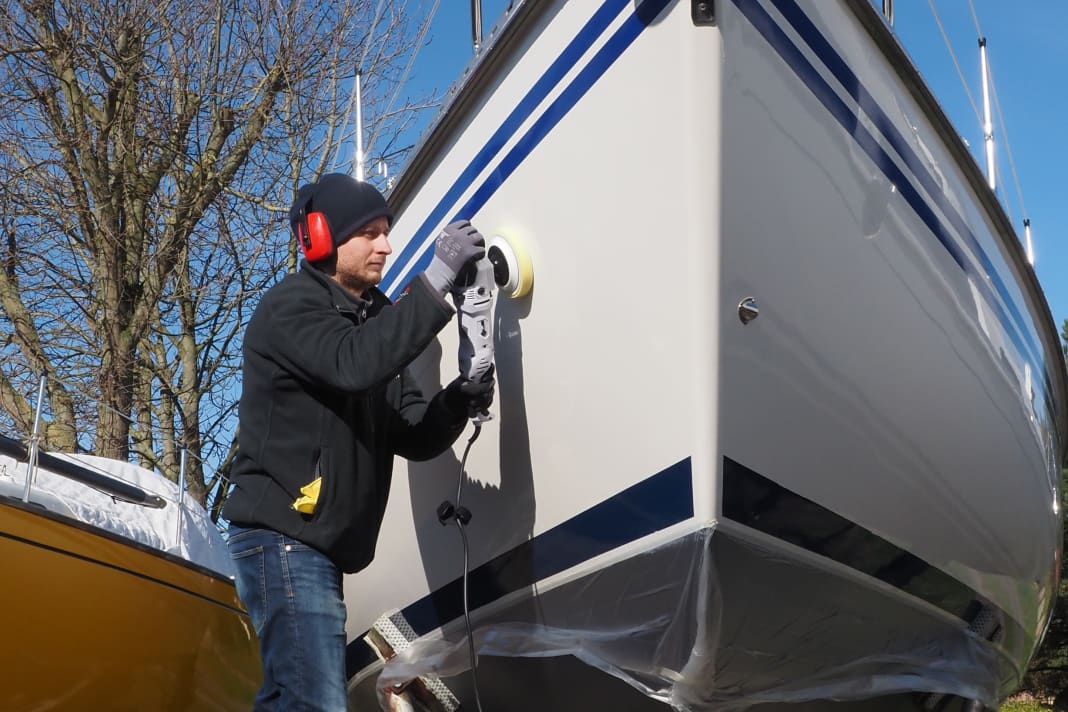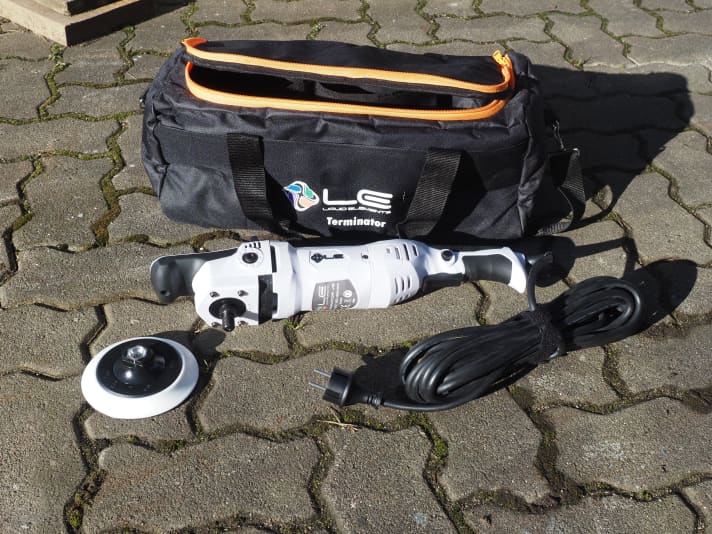





In the individual test we had the Terminator V2 rotary polishing machine from Liquid Elements. The machine costs 139 euros, but it's worth browsing online: you'll find sets that are hardly any more expensive, but some of them include polishing pads, microfibre cloths or even polishing pastes.
The test surface was the freeboard of a 32-foot yacht. The surface was already shiny, so there was no need to create a gloss in several steps. For comparison, we had a polishing machine from Flex, which is more than twice as expensive as the Terminator V2.

Equipment
The polishing machine from Liquid Elements comes in a practical bag that also has space for polish, pads and microfibre cloths. Apart from the machine, the polishing disc and an Allen key and open-end spanner (for changing the disc), no accessories are included. Practical detail: The power cable is a generous 8 metres long. It is also soft and does not get caught easily. This makes work much easier. An additional handle is not included, but was not missing when polishing. The speed of the 125 millimetre disc can be adjusted between 1,000 and 3,000 revolutions per minute in 11 stages using the rotary wheel. The machine has a special feature: there is a green and red LED above the speed control to indicate whether the contact pressure at work is ideal. However, this indicator is not helpful as the user's gaze always remains focussed on the surface to be polished and the LEDs are not in the field of vision.
Handling the polishing machine
The Terminator V2 sits comfortably in the hand and ends in a practical knob at the front. The device weighs 3.24 kilograms with cable, but as the connection is on the floor, only 2.46 kilograms have to be lifted. That's fine. Setting the speed is quick and intuitive. This is very good for applying the polish at the slowest speed and then polishing it out at around 2,000 revolutions. This worked well, even stubborn rain streaks under the bow fittings were quickly removed.
The Terminator V2 stands up to comparison with the more expensive Flex device. The biggest difference is the noise level. The Flex device is quite quiet, but hearing protection is strongly recommended for the Liquid Elements machine. If the polishing disc needs to be changed, for example to a smaller diameter to work between fittings, this can only be done with tools on the Liquid Element model. With the Flex, the disc can be locked at the touch of a button and then unscrewed by hand. This only makes a difference on the deck; the attachment did not have to be changed on the hull.
Conclusion
Liquid Elements offers with the Terminator V2 rotary polishing machine A very good polisher at a fair price. The work went well thanks to the easily adjustable speed, good handling and sufficient power (1,200 watts). The result was a beautiful shine on the hull.
Buying advice for polishing machines for sailing yachts
The main difference when making a purchase decision is to decide between the eccentric and rotary machine systems. Eccentric polishers have slightly more stroke than the familiar sanders. They are quieter in the hand, but the work is also much slower. Rotary machines sand more effectively, but also need to be held with more force and guided more sensitively. If you tilt them, you quickly produce streaks and the machine jerks and bucks in your hand. On the other hand, the work is done faster.
In addition to this major system-related difference, the market (especially online) offers a huge selection, which is particularly evident in the large price differences. There are many offers ranging from 60 to 400 euros. When making your choice, it is important that the machine has an easily adjustable speed range. Low speeds (around 1,000 revolutions or less) are useful for applying the polish, while 2,000 revolutions or more are recommended for polishing. It is helpful if the speed can be adjusted quickly using the rotary knob. If you have to click the switch several times, it is difficult to change the speed quickly. Devices with a battery seem practical, but often offer too little power and force you to take unwanted breaks when the battery needs to be charged.

